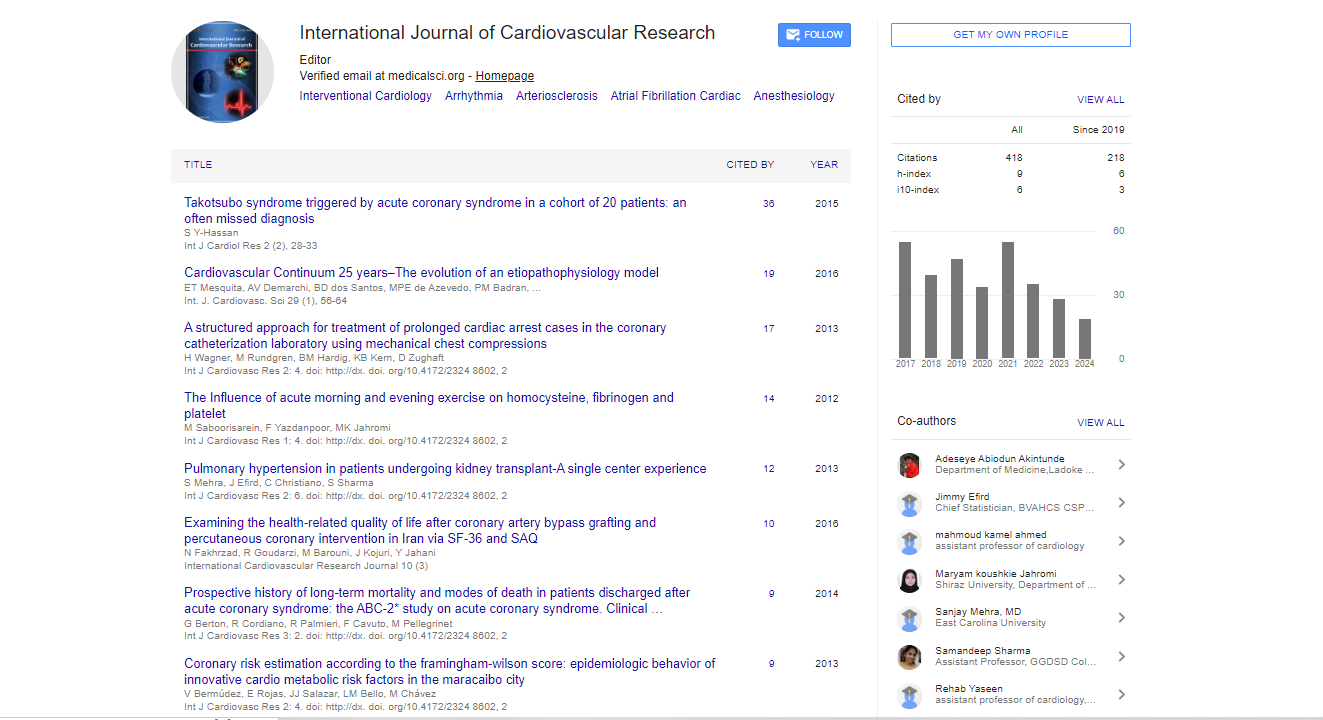Opinion Article, Int J Cardiol Res Vol: 13 Issue: 5
Artificial Intelligence in Cardiovascular Diagnostics
Alex Johnson*
1Department of Cardiology, Brigham and Women's Hospital, Boston, United States of America
*Corresponding Author: Alex Johnson,
Department of Cardiology, Brigham and Women's Hospital, Boston, United States
of America
E-mail: alex.johnson@gmail.com
Received date: 23 September, 2024 Manuscript No. ICRJ-24-153161;
Editor assigned date: 25 September, 2024, PreQC No. ICRJ-24-153161 (PQ);
Reviewed date: 09 October, 2024, QC No. ICRJ-24-153161;
Revised date: 16 October, 2024, Manuscript No. ICRJ-24-153161 (R);
Published date: 23 October, 2024, DOI: 10.4172/2324-8602.1000590
Citation: Johnson A (2024) Artificial Intelligence in Cardiovascular Diagnostics. Int J Cardiol Res 13:5.
Description
Cardiovascular Diseases (CVDs) remain one of the leading causes of death worldwide, prompting the healthcare community to continuously seek innovative approaches for early detection, accurate diagnosis and personalized treatment. In recent years, Artificial Intelligence (AI) has emerged as a transformative technology in the field of cardiovascular diagnostics. AI's ability to process vast amounts of medical data, recognize complex patterns and predict outcomes has the potential to revolutionize the way cardiovascular diseases are diagnosed and managed. Artificial intelligence refers to the simulation of human intelligence in machines that are programmed to think, learn and solve problems. In healthcare, AI encompasses a range of technologies, including Machine Learning (ML), Deep Learning (DL), Natural Language Processing (NLP) and computer vision. These technologies enable AI systems to analyze medical data such as medical images, Electronic Health Records (EHRs), genomic data and clinical notes and to provide insights that assist healthcare professionals in making accurate diagnoses and treatment decisions. Machine learning, a subset of AI, involves training algorithms to identify patterns in data without explicit programming. Deep learning, a more advanced form of machine learning, uses neural networks with multiple layers to analyze data with high complexity. In the context of cardiovascular diagnostics, these technologies can analyze a multitude of data points, ranging from imaging scans to patient history, to identify subtle changes that may indicate the presence of a cardiovascular condition. One of the most prominent applications of AI in cardiovascular diagnostics is in the analysis of medical imaging, such as echocardiograms, Electrocardiograms (ECGs), Computed Tomography (CT) scans and Magnetic Resonance Imaging (MRI). AIdriven algorithms, particularly those based on deep learning, can analyze imaging data to detect abnormalities such as plaques, arrhythmias, heart failure and Coronary Artery Disease (CAD) with AI's ability to analyze vast amounts of patient data allows for more accurate risk stratification and prediction of cardiovascular events.
Machine learning models can integrate data from electronic health records, including demographics, medical history, laboratory results and lifestyle factors, to predict a patient's risk of developing cardiovascular diseases. Wearable devices such as smartwatches and fitness trackers have become increasingly popular for monitoring cardiovascular health in real-time. These devices can collect data on heart rate, blood pressure, oxygen levels and physical activity, providing valuable insights into a person's cardiovascular status.
AI enhances the capabilities of these wearables by analyzing the data they collect and By integrating AI with wearable devices, healthcare providers can remotely monitor patients' cardiovascular health, enabling timely interventions and reducing hospital visits. This is especially beneficial for patients with chronic conditions like hypertension or heart failure, as AI-driven monitoring allows for continuous surveillance and early detection of potential complications. AI plays an important role in the development of personalized treatment plans for cardiovascular patients. By analyzing patient data, including genetic information, lifestyle factors and response to previous treatments, AI can assist in selecting the most appropriate therapies. The integration of AI into cardiovascular diagnostics offers numerous benefits. First and foremost, AI enhances diagnostic accuracy by reducing human error and identifying patterns that may not be immediately apparent to clinicians. Studies have shown that AI algorithms can match or outperform human experts in diagnosing certain cardiovascular conditions, such as CAD, atrial fibrillation and heart failure. Additionally, AI accelerates the diagnostic process, allowing for faster decision-making and reduced waiting times for patients. This is particularly important in emergency settings, where timely intervention can be the difference between life and death. Ethical considerations also come into play when using AI in healthcare. Ensuring patient privacy and data security is paramount, especially when dealing with sensitive health information. Additionally, there are concerns about the potential for AI to replace human healthcare professionals, leading to job displacement and reduced patient-provider interactions.
Conclusion
The future of AI in cardiovascular diagnostics is bright, with ongoing study and development pushing the boundaries of what is possible. As AI systems continue to evolve, they will become even more accurate, efficient and integrated into clinical workflows. The use of AI in personalized medicine will continue to grow, enabling cardiologists to deliver more precise and individualized care. In conclusion, AI is set to revolutionize cardiovascular diagnostics by improving accuracy, speed and personalization of care. While challenges remain, the benefits of AI in early detection, risk prediction and personalized treatment are undeniable. As the technology continues to advance, it holds the potential to significantly improve cardiovascular health outcomes and reduce the global burden of cardiovascular diseases.
 Spanish
Spanish  Chinese
Chinese  Russian
Russian  German
German  French
French  Japanese
Japanese  Portuguese
Portuguese  Hindi
Hindi 



